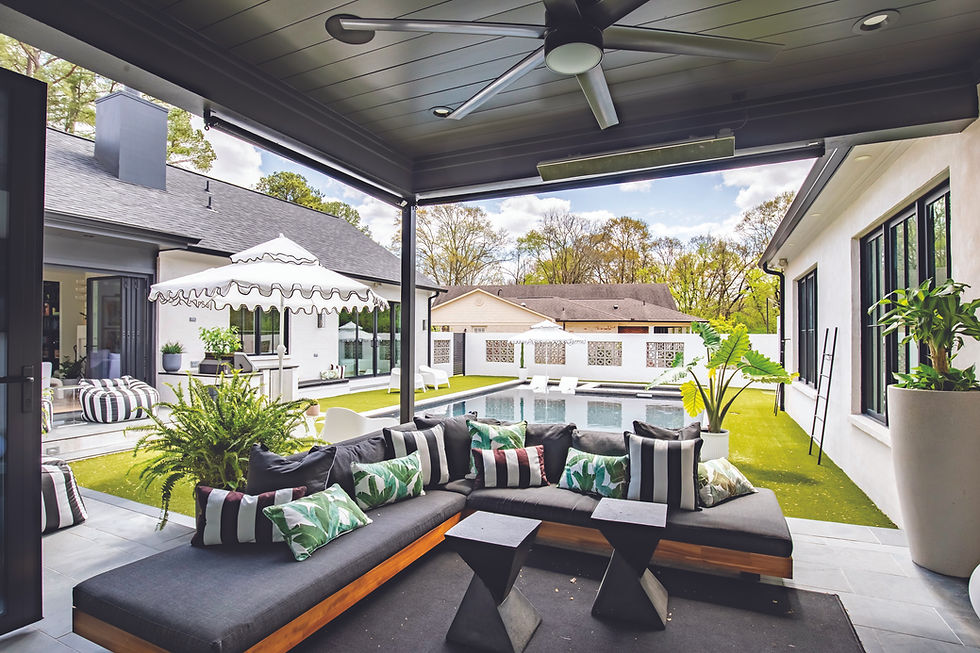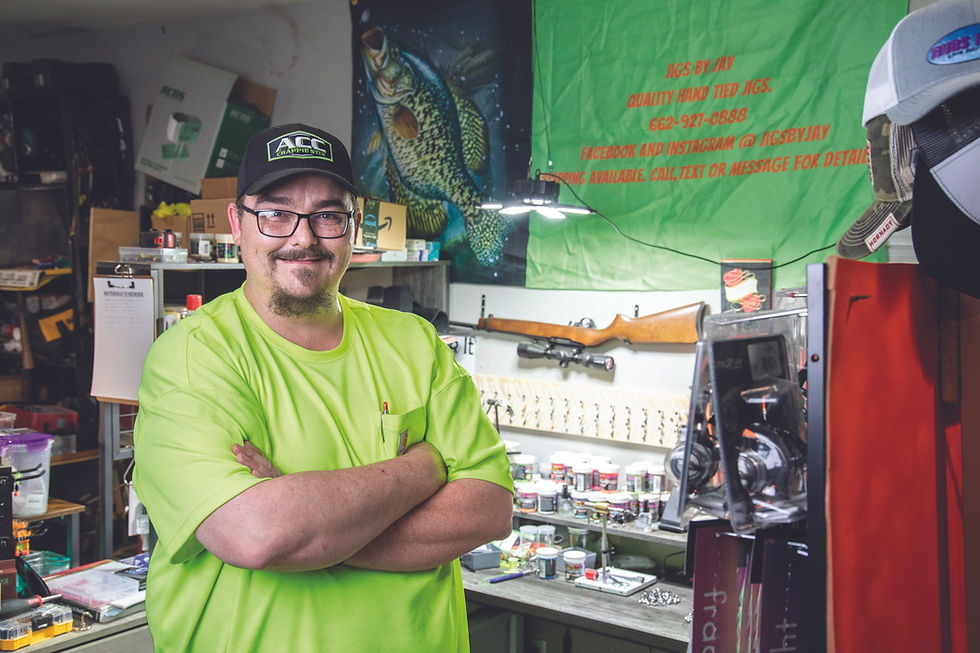A Passion for Houseplants
- Invitation

- May 2, 2024
- 5 min read
Oxford’s Angela Manley, an avid propagator of plants finds space in every room of her house for greenery to thrive.

Written by Leslie Criss | Photographed by Joe Worthem
Being labeled a phytophile would be considered high praise by Angela Manley. For those who’ve failed to keep flora among the living, a phytophile is any organism that thrives around plants. Manley is such an organism.
Manley, who moved to Oxford with her husband 16 years ago, grew up in Florida, where the temperatures allowed her parents to keep a vegetable garden year-round. And no growing things had to be moved indoors to survive winter.
“My first few years in Mississippi were a learning curve,” Manley said. “I killed a lot of plants.”
But Manley’s friend and co-worker at The Oil Shed in Oxford, Heather Sneed McClendon, had the perfect thing for Manley.
“I told her about this great book, ‘How Not to Kill Your Houseplant,’” McClendon said. “It’s a book I’ve shared with many who hope to become successful plant owners. And the internet has really turned many brown thumbs into green thumbs.”
The book is subtitled “Survival Tips for the Horticulturally Challenged” and is written by Veronica Peerless.
Manley lost some of her houseplants when she, husband Scott Paul and their three children were living in a smaller space while they built their new house. The Oil Shed became a regular stop for Manley to replenish her plant supply.
“I was in here a lot and one day just asked Kecia (Kirk) if I could work there,” Manley said, laughing. “Now I work at The Oil Shed one day a week.”
McClendon, who has worked at The Oil Shed since 2019, had something to add.
“Angela is almost our best customer,” she said.
The Oil Shed offers an abundance of indoor and outdoor plants, containers, unique gifts and lots of plant knowledge from staff members, several of whom are also Master Gardeners, including Manley.
A count of green plants in Manley’s home would be key in determining just how much of a plant lover she is.
“I don’t know,” she said at first. “I have purposefully not counted.”
However, once the question was asked, Manley’s own curiosity was piqued, and she counted her indoor plants.
“I have 72 plants — inside,” she texted.
And they are found in every room of her home, even the bathrooms.
“Bathrooms are the best places to put plants,” she said. “The humidity from the shower makes them do well.”
Manley’s plants, the larger ones, are all on rollers so she can easily roll the plants to different windows to catch the best sunlight in the winter.
Her children, ages 12, 10 and 7½, like their mother’s plants. They each have plants in their bedrooms and have developed an appreciation for them. But they don’t help take care of the plants.
“Now, they love to help me outside,” Manley said. “They’ve scattered hundreds of zinnia seeds. My daughter often says I like plants more than I like her. Of course, that’s not true.”
A former math teacher, Manley is as positive as Pollyanna when prodding people to purchase that first plant.
“That’s how you start,” she said. “You start with one or two plants.”
But it’s wise, she said, to put some planning into the process. There are things to consider, especially if one plans to have multiple plants.
“Do you want larger or more compact plants?” she said. “What room has the best lighting for a specific plant? There are plants that do well without light. How attentive do you want to be? Do you want flowering plants or just green?”
And don’t forget plant apps. Manley recommends: Planta and Greg. The apps can help the most novice plant lover become adept at helping them thrive with reminders to water, fertilize and much more.
“All a green thumb really is is know-ledge,” Manley said. “I purchased a fiddle-leaf fig once. They are temperamental and finicky. But I tried to learn how to care for it, and I’ve had it close to 15 years now. Believe me, there is a plant for everyone.”
7 Popular (& Hardy) Houseplants
If you’d like to test the greenness of your thumb, add to your already-existing collection of indoor plants or are just curious, Bob Marion, owner of Tupelo’s Mid-South Nursery, offers this primer on popular houseplants.
Source: Mid-South Nursery
Peace Lily
The peace lily is a flowering plant whose common name derives from the plant’s symbolism for peace, purity and healing. The peace lily helps filter the inside air and increases levels of humidity which, in turn, helps people to breathe better. Peace lilies should be watered once a week. “They are low-maintenance, very forgiving plants,” Marion said.
Ferns
Ferns are happy outdoors but are also at home inside. Ferns need to be misted as often as is practical as they will not tolerate dry conditions for long. They also need to be watered every four to five days. Ferns may offer health benefits, as they remove common airborne pollutants which have been thought to cause headaches, trouble breathing and the growth of cancerous cells. Because they are water-loving, ferns struggle in winter with dry heat, especially gas heat. “Ferns are not easy to grow, but I sell more ferns than just about anything else,” Marion said.
Succulents
Succulents are thick, fleshy plants that retain water in arid climates. Aloe vera is an example of a succulent. These plants are excellent at cleansing the air and removing toxins. Unlike their close cactus kin, succulents cannot take extreme heat. Plant them in well-drained soil and go easy on the water. They are low-light plants and very low maintenance. “Succulents can go two to three months without water,” Marion said.
Ficus
Ficus, commonly known as weeping fig, Benjamin fig or ficus tree, is native to Asia and Australia. It is the official tree of Bangkok and symbolizes peace and abundance in the Middle East. A ficus plant appreciates regular misting. Ficus plants can live as long as 20 years, and ficus tree varieties grown outside in containers and brought indoors in winter can live as long as 40 years. Ficus plants can be toxic to dogs. “Ficus plants are not easy to grow,” Marion said. “But people like them. They can always toss the unsuccessful plant, get another one and try again.”
Corn Plants
Corn plants are flowering plants native to tropical Africa. The plants have air-purifying properties and like indirect light, moderate temperatures and humidity. In the wild, the corn plant can grow up to 50 feet tall, but house plants are much smaller, typically growing from four to six feet.
Philodendron
Philodendron is one of approximately 450 species of stout-stemmed climbers of the family Araceae. The plant will grow in low light but will grow faster in bright, indirect sunlight. Direct sunlight can burn the leaves. “A perfect room for a philodendron, believe it or not, is the bathroom,” Marion said. “Some varieties can go 30 days without water in an air-conditioned house.”
Mother-in-Law’s Tongue
Mother-in-law’s tongue is native to tropical West Africa. An old-fashioned plant, it has become very popular among young people. Other names for this plant are snake plant, Saint George’s sword and viper’s bowstring hemp. These extremely low maintenance plants filter indoor air, remove toxic pollutants and may help boost mental health. “These plants have remained popular,” Marion said. “I’m 66, and I was selling these plants as a teenager when I was working here with my dad.”
A final piece of advice: Most house-plants respond well to monthly fertilization, Marion said. He also encourages plant owners to clean the leaves of houseplants. “Washing, cleaning and dusting plants makes a difference,” he said. “Just take a damp cloth two to three times a year and wipe the dust from the leaves. It will bring out the natural shine of the plant.”















Comments